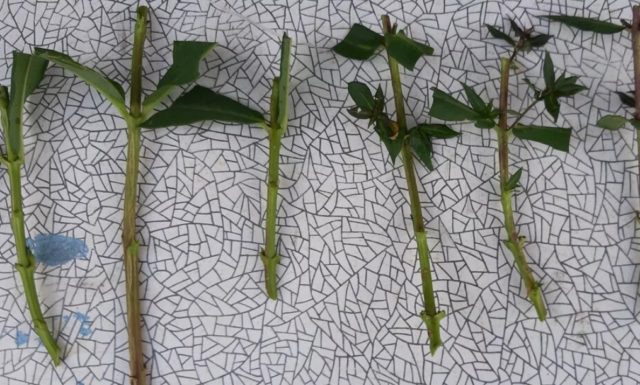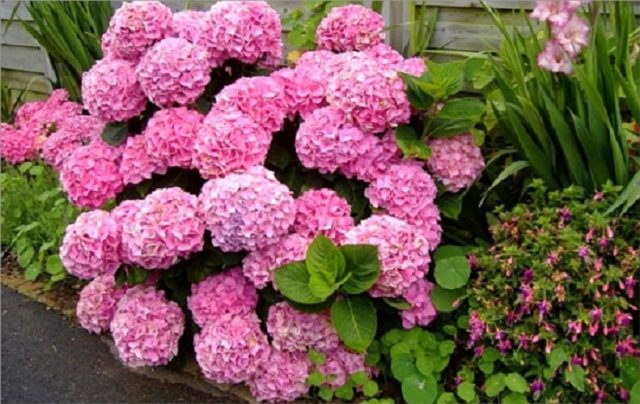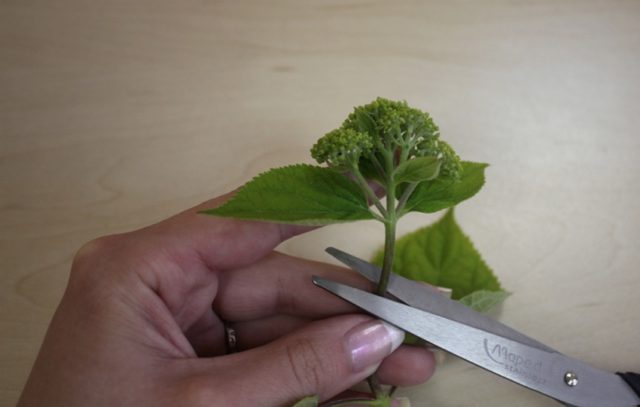Content
Propagating hydrangea by cuttings in the spring allows gardeners to grow a spectacular flower on their own. This is one of the easiest ways to obtain a view on a site. But there are nuances, without knowledge of which the procedure may be ineffective. It is important to familiarize yourself with the basic rules for propagating hydrangea using cuttings.

An effective way to help yourself propagate a flower for your site
Features of propagation of hydrangea by cuttings in spring
Gardeners consider this method to be more troublesome, but the most versatile and productive. It is applied to all types of amazing flowers. Cuttings are especially recommended for paniculate hydrangea. The technique allows you to obtain a large number of new plants.
It is recommended to carry out the procedure before tying buds. In addition to cuttings, hydrangea is propagated by dividing the bush or layering. But these options are less productive.
How to propagate hydrangea by cuttings in spring
For the process to be of high quality, it is necessary to adhere to the basic rules and steps. The main ones will be:
- deadlines;
- correct preparation of chubuchki;
- preparation of soil and containers;
- implementation of rooting technology;
- care and further cultivation of the seedling.
Hydrangea paniculata cuttings are carried out in the spring. The best time is the end of May, in some regions - the beginning of June. The operation is performed with green “spring” cuttings or, more correctly, the tips of the shoots. If you take cuttings at a later date, they will already be lignified. And such shoots take root much more difficult.
The main stage is the procurement of material.
Rules for taking cuttings
According to the recommendation of experts, as soon as buds begin to appear on the branches, it is time to take cuttings.

The final result depends on how correctly the cuttings are cut.
At this time, new shoots grow on the shoots. These green parts are the material for preparing the shanks. For rooting, you will need a part of the shoot that has more than one well-developed bud. The bush must be more than a year old.
You need to take the top part of the stem, but you should not cut cuttings from very thin shoots. They quickly rot, and the gardener is left without planting material. Then care should be taken to retain moisture. Therefore, the optimal time for cutting is early morning, when the plant tissue is filled with moisture. Make the lower cut at an angle of 45 °, the upper one – straight. The cut branches should be immediately placed in a container of water and not left in the sun. It should be recalled once again that propagation of paniculate hydrangea by woody cuttings in the spring is not recommended. This species is propagated only by green stems.

Proper preparation of cuttings is the key to successful propagation of hydrangea
Preparation of cuttings
This process does not take much time, but requires care:
- First of all, you need to remove the 2 bottom sheets, shorten the rest by half. If buds have already formed on the branch, they are cut off.
It is necessary to cut off the inflorescences, they draw a lot of strength from the stem
Place the cuttings in a growth stimulator solution for 2 hours. In this case, you need to make sure that the leaves remain dry. Suitable drugs are Epin Extra, Zircon or HB 101, which are used according to the instructions. If you don’t have such products at hand, you can prepare honey water at the rate of 1 tsp. for 1 glass of water. It also stimulates callus formation. - When the cuttings are removed from the solution, they need to be dusted with Kornevin or Heteroauxin before planting.
Dusting increases the cutting's ability to take root
Parts of the shoots prepared in this way are ready for further rooting.
Landing
Chubuchas can be planted in a special container or directly in the ground. The options for execution are not very different. But it’s worth considering each separately.
In container:
- Fill the prepared container with wet sand.
- Place the prepared planting material at an angle of 45°, deepening the lower internode by 2-3 cm.Important! Parts of the shoots should not come into contact with the leaves and sand or with each other.
- Spray the planting with clean water.
- Cover with a glass or film cap and transfer future hydrangea seedlings to the shade.
- Monitor soil moisture and the general condition of the cuttings.
If it is summer with the usual daytime (+ 20-25 °C) and nighttime (+ 18-15 °C) temperatures, then 1 month is enough for rooting. Then you will need to grow in separate containers.Experienced gardeners advise propagating hydrangea by cuttings in the spring at home immediately in separate transparent cups. This makes it possible to clearly see the appearance of roots.
Directly into the ground:
- Organize cuttings in a shaded area of the garden. To do this, dig a trench 20 cm deep. Place a drainage layer on the bottom, then a layer of nutrient soil and then sand (1-2 cm).
- Plant prepared hydrangea cuttings at an angle.
- Install arcs.
- Cover with film.
- Water 1-2 times a week, ventilate periodically.
As soon as new apical leaves appear on the hydrangea stems, remove the cover.
There is another popular way to propagate hydrangeas in the spring - germinating cuttings in water. It requires some skills so that the planting material does not rot.

Ordinary water can replace the labor-intensive process of cuttings
Process algorithm:
- Cut the twigs into 15 cm long pieces.
- Trim the top part above the last bud.
- Remove leaves.
- Take a transparent container and pour settled clean water. You can add any rooting agent.
- Change the water daily, preventing it from rotting. However, many gardeners prefer to simply add water, considering this option more practical and gentler on the roots. One careless movement can injure them and lead to the death of the cutting.
- Keep the cuttings in water until the roots reach 2 cm in length. This period usually takes 3-5 weeks.
You should not put many branches in one container. It is better to leave no more than 3 pieces.
Additional information on propagating hydrangea from cuttings:
Caring for cuttings
Good rooting takes place only in a shaded place.Therefore, containers with planted plants are removed from light, periodically watered and ventilated. As soon as the first signs of rooting appear, each specimen is transplanted into a separate container with loose nutrient soil. The plants can be planted next year, so they will have to be grown in winter. The best place is a greenhouse. If this is not possible, then the containers need to be buried on the site and properly covered. It is recommended to build a small frame, stretch lutrasil on top, then a layer of spruce branches and again insulation. Do not cover with polyethylene, which does not allow air to pass through.
Transplantation to a permanent place
Next spring, the rooted hydrangea cuttings are ready to be transplanted to a permanent location. First they need to be hardened a little, gradually accustoming them to the ambient temperature. If the seedlings are not strong enough, you can move them to a school for additional growing. Transplantation can be carried out only when warm weather sets in.
When transplanting, add 1 tbsp to each hole. spoon of mineral complex fertilizer. The day before the procedure, do not water the plant! This will allow the earthen lump to be well separated from the walls of the container.
After planting, cut the hydrangea by 2/3 of its length so that the bush grows more luxuriously. If the composition requires a medium-sized plant, then pruning is not necessary.

Accurate execution of hydrangea cuttings makes it possible to decorate the area with amazing flowers
Conclusion
Even novice gardeners can propagate hydrangea by cuttings in the spring. It will take a little knowledge, practice and confidence. The plant takes root very well if the rules of procedure are followed.










